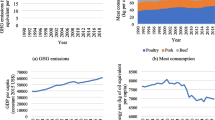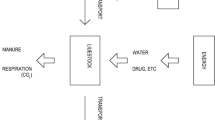Abstract
This study empirically investigates the effect of meat consumption on greenhouse gas emissions (carbon dioxide, methane, and nitrous oxide) in the USA. The impact of meat consumption on greenhouse gas emissions is examined by controlling for economic growth and energy consumption. The empirical analysis finds that all these variables are cointegrated for the long run. Moreover, meat consumption aggravates greenhouse gas emissions. Specifically, meat consumption (except for beef) has a U-shaped relationship with carbon emissions and an inverted U-shaped relationship with methane and nitrous oxide emissions. The causality analysis indicates a unidirectional causality running from meat consumption to greenhouse gas emissions. These empirical findings indicate that the US livestock sector has the potential to become more environmentally friendly with careful policy formulation and implementation.

Similar content being viewed by others
Data availability
Available upon request.
References
Alam MS, Shahbaz M, Paramati SR (2015) The role of financial development and economic misery on life expectancy: evidence from post financial reforms in India. Soc Indic Res 128(2):481–497
Ang JB (2007) CO2 emissions, energy consumption, and output in France. Energy Policy 35(10):4772–4778
Apergis N, Payne JE (2009) CO2 emissions, energy usage, and output in Central America. Energy Policy 37(8):3282–3286
Banerjee A, Dolado J, Mestre R (1998) Error-correction mechanism tests for cointegration in a single-equation framework. J Time Ser Anal 19(3):267–283
Bayer C, Hanck C (2013) Combining non-cointegration tests. J Time Ser Anal 34:83–95
Bin S, Dowlatabadi H (2005) Consumer lifestyle approach to US energy use and the related CO2 emissions. Energy Policy 33(2):197–208
Boswijk HP (1994) Testing for an unstable root in conditional and structural error correction models. J Econ 63(1):37–60
Camilleri AR, Larrick RP, Hossain S, Patino-Echeverri D (2019) Consumers underestimate the emissions associated with food but are aided by labels. Nat Clim Chang 9(1):53–58
Caro D, Davis SJ, Bastianoni S, Caldeira K (2017) Greenhouse gas emissions due to meat production in the last fifty years. In: Ahmed M, Stockle CO (eds) Quantification of climate variability, adaptation and mitigation for agricultural sustainability. Springer International, Cham, pp 27–37
Churchill SA, Inekwe J, Smyth R, Zhang X (2019) R&D intensity and carbon emissions in the G7: 1870–2014. Energy Econ 80:30–37
Daly HE (1996) Consumption: value added, physical transformation, and welfare. In: In: Getting down to Earth: practical applications of ecological economics, 49–60. Island Press, Washington
De Klein CAM, Eckard RJ (2008) Targeted technologies for nitrous oxide abatement from animal agriculture. Aust J Exp Agric 48(2):14–20
de Vries M, de Boer IJM (2010) Comparing environmental impacts for livestock products: a review of life cycle assessments. Livest Sci 128(1–3):1–11
Dickey DA, Fuller WA (1979) Distribution of the estimators for autoregressive time series with a unit root. J Am Stat Assoc 74(366):427–431
Dogan E, Ozturk I (2017) The influence of renewable and non-renewable energy consumption and real income on CO2 emissions in the USA: evidence from structural break tests. Environ Sci Pollut Res 24(11):10846–10854
Dogan E, Turkekul B (2016) CO2 emissions, real output, energy consumption, trade, urbanization and financial development: testing the EKC hypothesis for the USA. Environ Sci Pollut Res 23(2):1203–1213
Duchin F (1998) Structural economics: measuring change in technology, lifestyles, and the environment. Island Press, Washington and Covelo
Dyer JA, Worth DE, Vergé XPC, Desjardins RL (2020) Impact of recommended red meat consumption in Canada on the carbon footprint of Canadian livestock production. J Clean Prod 266:121785
Earth Policy Institute. (2017). Data Center – Food and Agriculture. (Dataset). Rutgers University. Retrieved from http://www.earth-policy.org/data_center/C24. Accessed 27 Apr 2017
Eckard RJ, Grainger C, de Klein CAM (2010) Options for the abatement of methane and nitrous oxide from ruminant production: a review. Livest Sci 130:47–56
Engle RF, Granger CWJ (1987) Co-integration and error correction: representation, estimation and testing. Econometrica 55(2):251–276
Fisher R (1932) Statistical methods for research workers. Oliver and Boyd, London
Galeotti M, Lanza A (1999) Richer and cleaner? A study on carbon dioxide emissions in developing countries. Energy Policy 27(10):565–573
Gerber PJ, Steinfeld H, Henderson B, Mottet A, Opio C, Dijkman J, Falcucci A, Tempio G (2013) Tackling climate change through livestock – a global assessment of emissions and mitigation opportunities. Food and Agriculture Organization of the United Nations (FAO), Rome
Grainger C, Beauchemin KA (2011) Can enteric methane emissions from ruminants be lowered without lowering their production? Anim Feed Sci Technol 166–167(2011):308–320
Granger CWJ (1969) Investigating causal relations by econometric models and cross-spectral methods. Econometrica 36:424–438
Hamit-Haggar M (2012) Greenhouse gas emissions, energy consumption and economic growth: a panel cointegration analysis from Canadian industrial sector perspective. Energy Econ 34(1):358–364
Holtz-Eakin D, Selden TM (1995) Stoking the fires? CO2 emissions and economic growth. J Public Econ 57(1):85–101
IPCC (2013) Climate change 2013 – the physical science basis: working group I contribution to the fifth assessment report of the Intergovernmental Panel on Climate Change. Cambridge University Press, Cambridge
Jin L, Duan K, Tang X (2018) What is the relationship between technological innovation and energy consumption? Empirical analysis based on provincial panel data from China. Sustainability 10(1):145
Johansen S (1991) Estimation and hypothesis testing of cointegration vectors in Gaussian vector autoregressive models. Econometrica 59(6):1551–1580
Khan MA, Khan MZ, Zaman K, Naz L (2014) Global estimates of energy consumption and greenhouse gas emissions. Renew Sust Energ Rev 29:336–344
Khan Z, Ali S, Umar M, D. Kirikkaleli, and Jiao Z. 2020. Consumption-based carbon emissions and international trade in G7 countries: the role of environmental innovation and renewable energy. Sci Total Environ 138945.
Kim D, Perron P (2009) Unit root tests allowing for a break in the trend function at an unknown time under both the null and alternative hypotheses. J Econ 148(1):1–13
Kuznets S (1955) Economic growth and income inequality. Am Econ Rev 49:1–28
Lind JT, Mehlum H (2010) With or without U? The appropriate test for a U-shaped relationship. Oxf Bull Econ Stat 72(1):109–118
Luo J, De Klein CAM, Ledgard SF, Saggar S (2010) Management options to reduce nitrous oxide emissions from intensively grazed pastures: a review. Agric Ecosyst Environ 136(3):282–291
McMichael AJ, Powles JW, Butler CD, Uauy R (2007) Food, livestock production, energy, climate change, and health. Lancet 370(9594):1253–1263
Murad MW, Alam MM, Noman AHM, Ozturk I (2019) Dynamics of technological innovation, energy consumption, energy price and economic growth in Denmark. Environ Prog Sustain Energy 38(1):22–29
Narayan PK (2005) The saving and investment nexus for China: evidence from cointegration tests. Appl Econ 37(17):1979–1990
North American Meat Institute (2017) The United States meat industry at a glance. North American Meat Institute, Washington Retrieved from https://www.meatinstitute.org/index.php?ht=d/sp/i/47465/pid/47465. Accessed 27 Apr 2017
Pao HT, Tsai CM (2010) CO2 emissions, energy consumption and economic growth in BRIC countries. Energy Policy 38(12):7850–7860
Pao HT, Tsai CM (2011) Multivariate Granger causality between CO2 emissions, energy consumption, FDI (foreign direct investment) and GDP (gross domestic product): evidence from a panel of BRIC (Brazil, Russian Federation, India, and China) countries. Energy 36(1):685–693
Pesaran MH, Shin Y, Smith RJ (2001) Bounds testing approaches to the analysis of level relationships. J Appl Econ 16:289–326
Phillips PCB, Perron P (1988) Testing for a unit root in time series regression. Biometrika 75(2):335–346
Röös E, Sundberg C, Tidåker P, Strid I, Hansson P-A (2013) Can carbon footprint serve as an indicator of the environmental impact of meat production? Ecol Indic 24:573–581
Said SE, Dickey DA (1984) Testing for unit roots in autoregressive-moving average models of unknown order. Biometrika 71(3):599–607
Schipper L, Bartlett S, Hawk D, Vine E (1989) Linking life-styles and energy use: a matter of time? Annu Rev Energy 14(1):273–320
Selden TM, Song D (1994) Environmental quality and development: is there a Kuznets curve for air pollution emissions? J Environ Econ Manag 27(2):147–162
Shafiullah M, Okafor LE, Khalid U (2019) Determinants of international tourism demand: evidence from Australian states and territories. Tour Econ 25(2):274–296
Shafiullah M, Chaudhry SM, Shahbaz M, Reboredo JC (2020) Quantile causality and dependence between crude oil and precious metal prices. Int J Financ Econ. https://doi.org/10.1002/ijfe.2119
Shahbaz M, Khan S, Tahir MI (2013) The dynamic links between energy consumption, economic growth, financial development and trade in China: fresh evidence from multivariate framework analysis. Energy Econ 40:8–21
Shahbaz M, Lean HH (2012) Does financial development increase energy consumption? The role of industrialization and urbanization in Tunisia. Energy Policy 40:473–479
Shahbaz M, Shafiullah M, Papavassiliou V, Hammoudeh S (2017) The CO2-growth nexus revisited: a nonparametric analysis for G7 economies over nearly two centuries. Energy Econ 65:183–193
Shahbaz M, Shafiullah M, Mahalik MK (2019) The dynamics of financial development, globalisation, economic growth and life expectancy in Sub-Saharan Africa. Aust Econ Pap 58(4):444–479
Shahbaz M, Shafiullah, M, Khalid U, and Song M. 2020. A nonparametric analysis of energy environmental Kuznets curve in Chinese provinces. Energy Econ 89. doi: https://doi.org/10.1016/j.eneco.2020.104814, 104814
Sinha A, Shah MI, Sengupta T, Jiao Z (2020) Analyzing technology-emissions association in Top-10 polluted MENA countries: how to ascertain sustainable development by quantile modeling approach. J Environ Manag 267:110602
Soytas U, Sari R, Ewing BT (2007) Energy consumption, income, and carbon emissions in the United States. Ecol Econ 62(3):482–489
Steinfeld H, Gerber P, Wassenaar T, Castel V, Rosales M, De Haan C (2006) Livestock’s long shadow: environmental issues and options. Food and Agriculture Organization of the United Nations, Rome
Stock J, Watson M (1993) A simple estimator of cointegrating vectors in higher order integrated systems. Econometrica 61(4):783–820
Subak S (1999) Global environmental costs of beef production. Ecol Econ 30(1):79–91
Toda HY, Phillips PCB (1993) Vector autoregressions and causality. Econometrica 61:1367–1393
Toda HY, Yamamoto T (1995) Statistical inferences in vector autoregressions with possibly integrated processes. J Econ 66:225–250
Weber C, Perrels A (2000) Modelling lifestyle effects on energy demand and related emissions. Energy Policy 28(8):549–566
World Bank (2017) World development indicators (dataset). The World Bank, Washington Retrieved from http://databank.worldbank.org/data/reports.aspx?source=world-development-indicators. Accessed 27 Apr 2017
Zivot E, Andrews DWK (1992) Further evidence on the great crash, the oil price shock and the unit root hypothesis. J Bus Econ Stat 10(3):251–270
Author information
Authors and Affiliations
Contributions
Conceptualization: Muhammad Shafiullah and Usman Khalid; Methodology: Muhammad Shafiullah and Muhammad Shahbaz; Formal analysis and investigation: Muhammad Shafiullah and Usman Khalid; Writing and preparation of the original draft: Usman Khalid and Muhammad Shafiullah; Writing, reviewing, and editing: Usman Khalid, Muhammad Shafiullah, and Muhammad Shahbaz; Resources: Muhammad Shafiullah and Muhammad Shahbaz; Supervision: Muhammad Shahbaz.
Corresponding author
Ethics declarations
Conflict of interest
The authors declare that they have no conflict of interest.
Ethical approval
N/A. Publicly available data implemented in empirical analysis.
Consent to participate
N/A. Publicly available data implemented in empirical analysis.
Consent to publish
N/A. Publicly available data implemented in empirical analysis.
Additional information
Responsible Editor: Philippe Garrigues
Publisher’s note
Springer Nature remains neutral with regard to jurisdictional claims in published maps and institutional affiliations.
Appendix
Appendix
Rights and permissions
About this article
Cite this article
Shafiullah, M., Khalid, U. & Shahbaz, M. Does meat consumption exacerbate greenhouse gas emissions? Evidence from US data. Environ Sci Pollut Res 28, 11415–11429 (2021). https://doi.org/10.1007/s11356-020-11331-9
Received:
Accepted:
Published:
Issue Date:
DOI: https://doi.org/10.1007/s11356-020-11331-9




